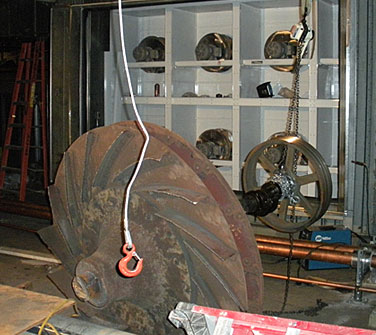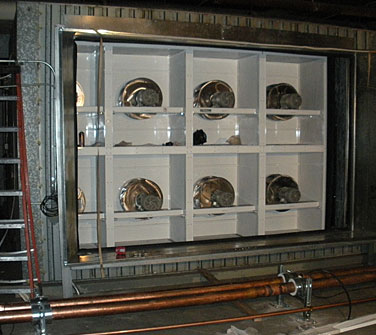FANWALL TECHNOLOGY Fits the Need
A few years previously, Barger had learned of a new technology that eliminated the problems associated with like-for-like replacement of DWDI housed fans — specifically, the difficulties and expense of removing the old fan and bringing in a new 2,000-lb. unit to mechanical rooms that are typically buried deep in a building. Barger was aware of FANWALL TECHNOLOGY — a modular system of small fans and motors that work together to create the same cubic feet per minute (cfm) as a single, large air handler fan — but he had never used the technology in a retrofit.
Barger met at the site with Shaun Webster, sales engineer for Norman Wright, the local manufacturers’ representative for Nortek Air Solutions. Barger’s idea was to gut the cabinet of the air handler, retain the 20’ x 10’ x 30’ chassis and build it up to meet Woodfin’s expectations as well as budget. From his experience with FANWALL TECHNOLOGY, Webster knew the idea would work.
“These systems, which are custom engineered for each project to match the exact requirements, use many small fans and motors to do the work of one large fan and motor,” said Webster. The reason is simple: if a large fan or motor like the one at the Hilton fails, the result is 100 percent failure of the air handling system. “But if there’s a failure in the array of FANWALL TECHNOLOGY fans or motors, the VFD-based system (variable frequency drive) can pick up the slack and adjust the operating speed of each cell to provide the required airflow until the failed unit can be replaced.”
A FANWALL system consists of a number of individual cube-shaped cells, each of which houses a fan, motor and electrical connections. Fan systems are custom-configured by selecting the number of fans, wheel diameter, blade width and rpm. This allows the most efficient design to be developed for each application, according to Webster. In the Hilton’s twelfth-floor mechanical room, eight FANWALL TECHNOLOGY cells (stacked two high by four wide) provide the same 48,000 cfm as the old air handler. Each 550-pound cell measures 29 inches deep, small enough to be loaded onto a cart and wheeled through the 36-inch-wide mechanical room door.
In addition to the new fan system, the retrofit design solved the steam heat issue with four-zone VAV with hot water reheat. This included running four-inch hot water piping to variable air volume controls with hot water reheat, creating a more efficient path into the chilled water coil to increase performance, and installing new copper fin, copper tube-chilled water coils, new stainless steel control dampers, and linkages for improved durability. “This proposal was a definite improvement in controlling the temperature and operating cost of the project, and Hilton awarded us the bid,” said Barger. “The FANWALL TECHNOLOGY cells made it easy to accomplish the retrofit to provide the capacity of the original design and have the ability to reduce fan energy when zones are not occupied.”
How They Did It
“I had never heard of FANWALL TECHNOLOGY, but I liked the idea that the solution would keep us within our budget,” said Brian Mork, director of property operations, Hilton San Francisco. “The labor costs for demolition and assembly we were looking at for the other alternatives would have significantly increased the cost of the project.” The entire project was completed in stages over eight days while minimizing any disruption to guests at the hotel. Installation of the FANWALL system was a fraction of that time. “We started at about 8 o’clock in the morning and finished by 10 AM,” said Josh Mauer, dryside foreman, Allied Heating and Air Conditioning.
The most time-consuming part was demolishing the eight-foot-tall fan and associated ductwork and coils. Preconstruction was a priority, and each step was scheduled to ensure all trades could complete their work to meet the timetable. “Each fitting had to be staged like a puzzle as we built ourselves out,” said Barger. The rest of the time was devoted to rigging six chilled water coils in place, connecting ducts, adding control dampers and hot water reheat coils.
Low Maintenance, Quiet Operation Contribute to Benefits
FANWALL TECHNOLOGY offers many advantages over conventional air handler fans. One is in the area of maintenance. The direct-drive design requires no belts, the HVAC component most likely to fail or degrade performance over time. The new fan assembly also eliminates lubrication requirements with permanently lubricated motors and bearings.
Other key FANWALL TECHNOLOGY advantages are low vibration and quiet operation. Careful attention to balance within each of the fan wheels significantly reduces vibration and, as is the case with Hilton, eliminated the need for a concrete inertia base and spring isolation. Small fans operating at relatively high speeds produce less troublesome low-frequency sound than lower speed large fans. Noise reduction is accomplished using the patented Coplaner Silencer® of FANWALL TECHNOLOGY, which surrounds the fan and motor with sound-absorbing material to cancel noise.
“If you went into the fan room where the Hilton’s air handler was operating, it was so loud that you could barely hear yourself talk,” said Webster. “After the FANWALL system was installed, I brought all the Hilton engineers in there for training while the system was operating at 100 percent of its airflow capacity, and we were able to have a normal conversation.”
Besides being noisy, the old air handler operated at a constant speed, so output could not be adjusted to meet the actual airflow needs in the four hallways it served. The new FANWALL system combined a variable frequency drive and control system to automatically adjust fan speed, depending on the situation. For example, if just one of the hallways is occupied, the fans are slowed to deliver only the amount of airflow needed by that hallway, boosting energy efficiency.
Project Tackles other HVAC Challenges
At the Hilton San Francisco, energy efficiency was also improved by reducing “system effect.” According to Webster, this was accomplished by removing “a lot of the junk in the airstream” that was inhibiting airflow and adding to static pressure losses. For example, the old transition ductwork downstream of the fan included a restriction that was causing a large amount of static pressure loss. This section of ductwork was replaced with a new duct with a wider opening and no restrictions, improving airflow and saving energy.
All in all, FANWALL TECHNOLOGY “seemed to fit our needs better” than the four-air handler solution, said Mork. “Energy is always a big criterion for me. In all, the FANWALL system saved about 137,000 kWh of energy over the first year compared to the old air handling system.” As a result, he added, the Hilton San Francisco received a $13,000 rebate from Pacific Gas and Electric, the local utility.
The best benefit for hotel guests and staff alike is that ventilation in the ballroom foyers is now comfortable and easy to control. And for future needs, hotel engineers have a new way of approaching air handling retrofits.
Retrofit vs. Replacement
For air handlers that are reaching the end of their service life, replacing existing fans and other components can be the most cost-effective solution for avoiding the cost and business disruption of an air handler failure. Access limitations, however, are a barrier to many replacements. FANWALL systems can minimize these and other barriers.
- An air handler cabinet can retain its integrity well beyond fans, coils and other components, allowing it to be retained.
- The modular design of FANWALL systems allows individual cubes to be navigated through a standard 3-foot door and assembled inside the existing air handler cabinet.
- There is no need to have a crane on site as is often the case with larger conventional fans.
- The performance of the new system can be upgraded to better match actual capacity and airflow requirements.
- Ancillary components such as sound attenuators and air blenders that created static pressure penalties in the old system can be removed.
- Design flaws and other maintenance concerns — such as component access issues and corrosion — can also be addressed, essentially resulting in a new, more efficient air handler in an old skin.
- All of this often can occur over a weekend or during unoccupied time frames to minimize downtime or disruption of normal business.


